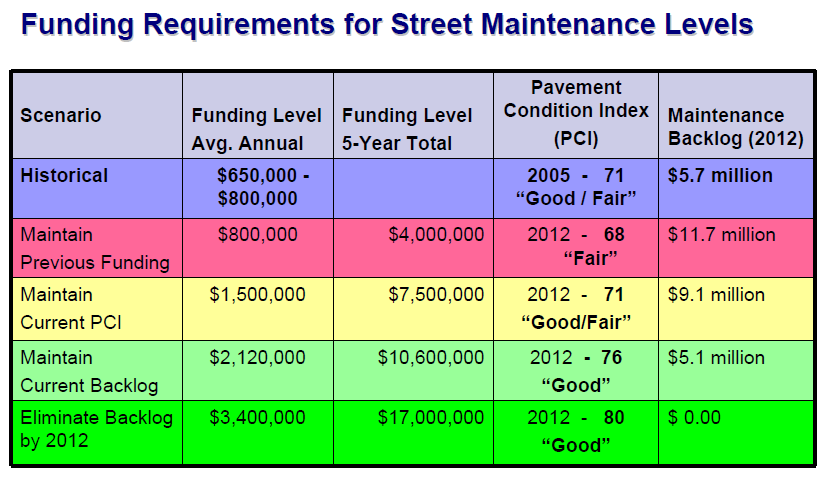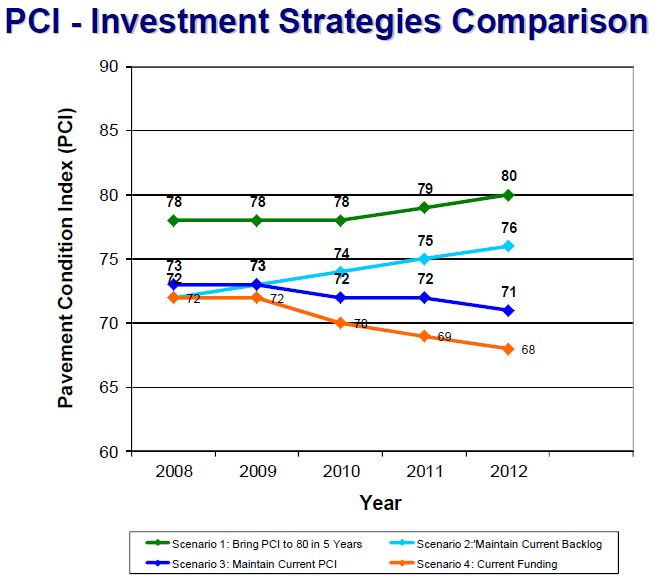 Given the road work that is either planned or has occurred on Second, Third, and Fifth Streets thanks largely to grant funding, it might seem inconceivable that Davis roadways are reaching critical levels of maintenance. But that is exactly what we face.
Given the road work that is either planned or has occurred on Second, Third, and Fifth Streets thanks largely to grant funding, it might seem inconceivable that Davis roadways are reaching critical levels of maintenance. But that is exactly what we face.
According to a report last week, the city has a baseline funding shortfall of $1.62 million. The city has relied heavily on one-time funding over the past two years from Proposition 1B and Federal Stimulus funding. However, that money is gone and those funding sources are gone with them.

As we reported last summer, not only is the overall city grade on road conditions not great, but at the street-level view it is even worse.

The good news is that most of the worst road conditions are local and residential streets. Olive Drive is the exception as it is a freeway onramp. These are rated 4s and 5s on a ten-point scale traffic index. Larger arterials are rated an 8 or 9. With 7s being major arterials within neighborhoods.

Last year at this time, acting public works director Bob Clarke gave essentially the same report to council.
“In addition to the staffing cuts,” he reported, “our approximately $1 million a year road maintenance budget is down to $250,000 next year, which won’t buy us much pavement out in the field next year.”
“Something you’ll see immediately, some things won’t be apparent immediately but there will be impacts. Recovering from some of them will take awhile,” he said. “Much as my analogy would be if we don’t maintain our streets when we can do it cost effectively eventually they will fall apart and the cost to repair them will be much much more significant.”

Nothing has really changed in the last year except that the street conditions are probably worsening.
There are really two ways to look at this, at this point. First problem is that we are going to face a cutback in services to pay for the retirement packages of current city employees.
Second, about four years ago, the city was trumpeting the fact that it had a balanced budget. Indeed, in the 2008 council elections, Don Saylor and Stephen Souza were bragging about the balanced budget with a 15% reserve that they had maintained under their watch.
What they neglected to detail was that a lot of that balanced budget was created by assigning a category of unmet needs. On the books the numbers balanced out. But what was becoming more and more obvious was that we were deferring maintenance on roads because we could not afford it.
Where had the money gone? While the city was quick to talk about the fact that the state had raided local funds, the fact remains that the city augmented those losses through the half-cent sales tax and also had double-digit growth in property taxes throughout much of the last decade.
However, the city was unwise as to how it spent that money, giving employees huge raises and augmenting pensions to 3% at 50 for safety employees and 2.5% for miscellaneous employees.
Even at that time, those raises in pensions seemed unsustainable once the real estate market returned to more historic rates of growth. The problem was of course exacerbated when the market collapsed, cutting off a huge revenue stream to the city.
We need to understand at a very fundamental level that what has happened is that we have exchanged salaries and benefits of public employees for services. With CalPERS’ move last week to retain the 7.75% assumed rate of return for their pension investments, it is unclear whether the City of Davis will bear the full brunt of $7 million in increased payments or more.
But that money will come from basic services – parks, green belts, recreation, and yes, roadway repair.
Firefighters have often defended and rationalized their high pay, equating it with public safety. But if we end up with no money to repair our roads, are we not endangering public safety? If bike paths are cracked and warped, do we not put bicyclists at increased risk? Won’t such streets also lead to higher need for repairs to vehicles and possibly increased accident rates?
Moreover, by deferring maintenance, we are actually increasing the costs of it.

The cost of preventative maintenance is far cheaper than the costs of light rehab, heavy rehab, or outright reconstruction.
Yet look at the shape of some of these streets – we are now well beyond the need for preventative maintenance and rapidly looking into heavy rehab if not outright reconstruction.
We have been fortunate so far and the existence of the stimulus plan gave us an additional window, but those roosters are coming home to roost quite quickly.
At some point the city is going to have to create a road maintenance fund, either taking from existing programs or increasing the costs and fees associated with them.
—David M. Greenwald reporting

The Davis Public Works Department has a history of prioritizing “pouring new roads” over repair and maintenance in its road budget. This should be a Council concern as they consider approving new residential projects.
Roads are like people , they need retiree medical also …
After age 65, Avatar.
David, how old is that list of streets? I notice, for example, that B Street from Russell to 1st Street is on there (as a 51 PCI), yet that was re-surfaced about 3 months ago.
I have a feeling that this list is much more subjective than those specific PCI numbers would indicate. It also strikes me as there being a chance that the street graders are biased, perhaps giving a lower mark to a street that they, for their own purposes, want repaired.
To wit, I note that a section of Cornell Drive is on there as critically in need of repair. It’s scored as a 33. I can assure you, as a resident of a different section of Cornell Drive, that section which scores so badly is in decent shape. It’s really no different from any other secondary residential street in west central Davis, and nothing major* has been done to that section of Cornell since I noticed it on this list a year ago.
From my travels on Davis, I have found the single worst stretch of street surface is B Street from 8th to 5th. Yet that does not show up on any list of a critical need?
*There was some underground work done last summer, and then it was resurfaced where the underground work and sidewalk repair work was done. It’s not perfect where the resurfacing was done, but it is not at all hazardous. There are no major cracks or pot holes.
[i]At some point the city is going to have to create a road maintenance fund, either taking from existing programs or increasing the costs and fees associated with them.[/i]
Or perhaps RDA funds could be used for this purpose. I’ll just keep mentioning this any time the opportunity presents itself.
Why oh why weren’t the million spent for the downtown and 8th St bulb-outs used for repairing streets. My understanding is the grants could have been used. Sorry if typos, on iPhone and type is microscopic for some reason!
dmg: “Second, about four years ago, the city was trumpeting the fact that it had a balanced budget. Indeed, in the 2008 council elections, Don Saylor and Stephen Souza were bragging about the balanced budget with a 15% reserve that they had maintained under their watch.
What they neglected to detail was that a lot of that balanced budget was created by assigning a category of unmet needs. On the books the numbers balanced out. But what was becoming more and more obvious was that we were deferring maintenance on roads because we could not afford it.”
I objected to this sort of creative bookkeeping at the time, and have not changed my mind. It is incumbent on city staff and the City Council to be honest w citizens – w complete transparency, instead of creative bookkeeping. If I remember rightly, this “unmet need” category that resulted in a “balanced budget” was done at a time when some members of the Gang of Three were up for re-election. The creative bookkeeping met their political needs!
Secondly, the lack of road repair is showing up on the freeways as well. There are sections of I-80 around Davis that are awful. I hit a huge pothole the other day while driving, which I’m sure did wonders for the front end alignment on my car. The lack of road repair is going to be a major issue as funds dry up…
Thirdly, in the past it was not uncommon for streets to be repaved where it was not needed, just bc it was “on a schedule” to be repaved. It would seem to me there needs to be real prioritization of where the repairs are truly needed, rather than follow some arbitrary schedule.
Don Shor: “Or perhaps RDA funds could be used for this purpose. I’ll just keep mentioning this any time the opportunity presents itself.”
Only if RDAs are abolished; and only if funding from the abolished RDAs actually trickles down to the local level – instead of being sucked up by the state bureaucracy, the schools, the counties and cities for other things… but you can keep on hoping…
WHATEVER happened to the Stimulus funds? Hmm interesting..dissappeared in a flash down the public works, cops, firefighter union salary increases?